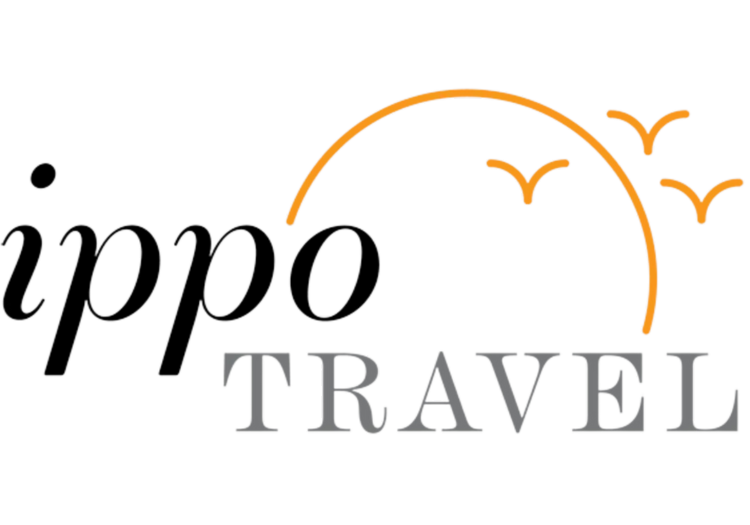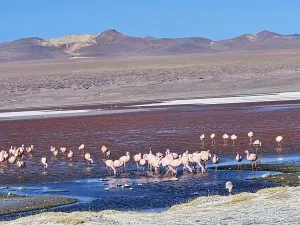What’s It Like To Visit Altiplano & Desert Land In South America?
IS IT WORTH THE VISIT?
Absolutely! It is a once-in-a-lifetime experience! It is an exploration to connect with the natural wonders. It is a discovery of the planet we live in.
With that being said, it is not for everyone. It’s great for adventure travelers. I’d like to share my experiences traveling in a small group. It was an exploration from San Pedro de Atacama in Chile into Uyuni Bolivia. It was a world experience, and it made me wonder what our planet might have been like ages ago.
San Pedro de Atacama is located in the Andes Mountains of the northeastern region of Chile near the southern border to Bolivia. Its landscape reminded me of pictures of Mars’ surface. It is also surrounded by rough conditions of nature; desert, salt lagoons, geysers and active volcanos.
Bolivia is a landlocked country and slightly smaller than twice the size of Texas. We visited the desert region, which is a small portion of the country.
HOW TO PREPARE FOR YOUR VISIT
Altiplano is a high plateau, specifically in the Bolivian and Peruvian Andes. The average elevation is about 12,000 feet above sea level. Before making a commitment for your travel, be aware of Travel to High Altitude.
Also, check the border entry requirements for a tourist visa. If you are a US passport holder, you are required to have a tourist visa for entering Bolivia. See a few options below. For vaccination requirements, be sure to give enough time for it to be effective.
If you are used to traveling to European countries where you can get around without trouble as an English speaker, South America is different. It definitely helps to speak some Spanish.
WHO WOULD ENJOY THE ITINERARY
It is suited for seasoned travelers who enjoy outdoor activities and be comfortable at remote locations. Adventure travelers and nature photographers come to my mind. You do not need to be an athlete but we were active almost every day. While there are several options for daily activity levels, this program would be a challenging itinerary for small children.
Whatever the activity we chose, we had a guide with us. We only carried a minimum of what we needed for the day in our backpacks (i.e., a water bottle and sunscreen).
We had delicious lunch waiting for us at the end of each hike and excursion. They were prepared with local ancient grains, vegetables and meat. Since I am not a meat eater, my meals were prepared without it. There were others who were gluten-free.
After exploring the natural wonders of the region, we came “home” to our nice and comfortable lodges at the end of the day.
SAN PEDRO DE ATACAMA, CHILE
We started our journey at the oasis of San Pedro de Atacama in Chile located at about 8,000 ft above sea level. It’s a cozy town located in the middle of the Atacama Desert about 60 miles from Calama airport. We spent a few days getting used to the high altitude.
This program is designed to acclimatize travelers before ascending to a higher elevation. We took an easy hike in the afternoon on our arrival day. The hiking terrain made me imagine what it might be like to walk on Mars without an oxygen mask.
As we continued with our acclimatization process, each traveler was able to choose activities of the day: hiking, mountain biking, horseback riding, overlanding and climbing. I hiked some more “Mars Land” in the morning the next day and I chose my afternoon activity to be floating in a salt lagoon looking over the majestic view of the Andes Mountains. The surface of the water was cold but warm enough to be floating for about 10 minutes. It was just perfect for me. Others were riding mountain bike and enjoying horseback riding.
On the last day in San Pedro de Atacama, we drove up the volcanic mountain roads toward its smoking crater. Migratory birds were getting ready for the winter season. Among them were the regional flamingos! The color contrast of the pink birds against the black and red mountain range with some snow was astonishingly beautiful. Do you know what flamingos sound like? They like to talk amongst each other.
We then reached the highest elevation point of the day, El Tatio Geyser, approximately 14k feet. Just imagine walking amongst the geyser spouts bubbling up here and there as you walk along.
The next step was a flat marsh field walk. As we descended down to a volcanic oasis, we spotted Vicuña herd and other wildlife such as Viscacha and Condors. They were not obvious to spot the first time since they were camouflaged in their natural environment well. But once I knew what to look for, they were everywhere!
As mentioned, each day we returned to our comfortable lodge where we were greeted by their staff of familiar faces. We took a nice warm shower, enjoyed local cuisine, and prepared for our activities for the next day.
ON THE WAY TO UYUNI, BOLIVIA
A few hours’ drive from the lodge in San Pedro de Atacama took us to the immigration office in Chile to depart from and drove to the border into Bolivia. Note there is no place to stop for a bathroom break and you could be waiting in a car until you are cleared to leave Chile.
Once you are cleared, you’d be in the neutral zone between Chile and Bolivia. We said goodbye to our guides in Chile and were greeted by our guides in Bolivia.
BORDER CROSSING
If you are a US passport holder, you must have a tourist visa (as of June 2023) to enter Bolivia. There are a few options to obtain one: (1) Obtain from the Consulate General’s office of your region (2) Use a travel visa and passport processing service company (3) Obtain it at the border. Connecting with Consulate General’s office could be challenging, so be sure to be in touch with them before sending your original passport. A visa processing company could not help me as the Consulate General’s office in my region required an in-person meeting (or a video meeting). So, my option was to acquire it at the border. See Getting a Bolivian visa at the border. I would, however, recommend obtaining it while you are in the US, if possible, to avoid the stresses of unknowns. These requirements may change and they are different depending on the passport of your citizenship. Be sure to check exactly what you need for your trip: entry requirements
JOURNEY THROUGH BOLIVIA TO UYUNI SALT FLAT
The elevation of the border crossing was above 13k feet. After crossing the border, we visited three lagoons: Laguna Blanca (White Lagoon), Laguna Verde (Green Lagoon), Laguna Colorada (Red Lagoon). Each lagoon has its own unique geological features and is obvious why they were named in those colors. Flamingos and other animals were spotted at the Laguna Colorada, Red Lagoon, which is located within Eduardo Avaroa Andean Fauna National Reserve at about 14k feet elevation.
One of the stops in Bolivia was a lava cave called “Galaxiae Aguaquiza” in the middle of a desert. When our car was parked, wood flute sounds with rolling tumbleweeds that I saw in Western cowboy films got played in my head. Inside the cave was fascinating as if I was walking inside a loofah sponge. The formation of the walls looked very delicate but they were as hard as bones.
When we drove back in the car, our guide told us to close our eyes till they told us to open them. We had been driving dirt roads on our comfy 4×4 SUV but I noticed the ground surface got changed. It was subtle and I didn’t bother to ask what it meant.
When the car was parked with our eyes closed, we were guided to a spot. With their countdown, we opened our eyes. WOW!!! We didn’t know how else to describe the view at that moment. It was absolutely stunning. I had seen snow-covered fields many times before, but this was not the same. The ground was all white but hard. I was looking for the horizon with a mountain range but all I could see was the dry white salt field. No one else was in our sight. If you focused, you could see a slight shape of islands in the distance.
June is a dry season. You can drive, walk and ride bicycles on the surface. Many photographers like the wet season because of the reflection on the salt flat; however, it is harder to get around the flat.
It looked like a fantasy world. The bright pure blue sky against the bright pure white salt flat was astonishingly beautiful. Once we took our breath and got used to the idea of being on the largest salt flat in the world, the Uyuni salt flat, we noticed our chairs were lined up for our lunch. What a luxury to sit in the middle of the salt flat and enjoy the lunch prepared for us with local wine in our hands!
We took lots of fun pictures and rode bicycles, climbed up an island to see the 360-degree view of the Uyui Salt Flat.
We also visited quinoa farm villages nearby. I thought they were very picturesque, but some of the buildings were abandoned as their younger generations moved to cities.
Just as we did in Atacama, Chile, we returned to our comfortable lodges each night where we enjoyed delicious local cuisine, interacted with local cooks, took warm showers, and slept on a large comfortable bed. The lodges are built at locations without destroying the view and they are modular style so the ground is not disturbed like a structure with concrete foundations. I enjoyed the daily sunrise and sunset from our windows. I was also fortunate to see a beautiful and almost mysterious moonrise over the volcanic mountain range one night.
This exploration rejuvenated and energized my body and soul.
Travel Tips:
Sunscreen is a must in all seasons and reapply every few hours.
Always have your water bottle with you, refill and drink lots of it!
Don’t forget sunglasses.
Hiking shoes with ankle support are recommended instead of sneakers/running shoes if you are going on a hike.
Your guides know where the restrooms are. Plan accordingly.











